HP Compaq Presario 2100, Compaq Presario 2100Z, Compaq Presario 2101AH, Compaq Presario 2101EA, Compaq Presario 2101EU Reference Guide
...
Compaq Notebook Series
Reference Guide

Notice
© 2002 Hewlett-Packard Company.
Microsoft, MS-DOS, and Windows are trademarks of Microsoft Corporation in the U.S. and/or other countries.
All other product names mentioned herein may be trademarks of their respective companies.
This product incorporates copyright protection technology that is protected by method claims of certain U.S. patents and other intellectual property rights owned by Macrovision Corporation and other rights owners. Use of this copyright protection technology must be authorized by Macrovision Corporation and is intended for home and other limited viewing uses only unless otherwise authorized by Macrovision Corporation. Reverse engineering or disassembly is prohibited.
HP shall not be liable for technical or editorial errors or omissions contained herein. The information is provided “as is” without warranty of any kind, and is subject to change without notice. The warranties for HP products are set forth in the express limited warranty statements accompanying such products. Nothing herein should be construed as constituting an additional warranty.
Compaq Notebook Series Reference Guide
First Edition (December 2002)
Reference Number: 2100/2500/N1050v
Part Number: 311069-001
ii Reference Guide

|
Important Safety Information |
|
|
CAUTION |
To reduce the risk of fire, use only No. 26 AWG or larger telecommunications |
|
line cord to connect a modem to the telephone wall jack. In Australia, the |
|
notebook must be connected to the Telecommunication Network through a |
|
line cord that meets the requirements of ACA Technical Standard TS008. |
|
|
When using your notebook with a telephone connection, always follow basic safety precautions to reduce the risk of fire, electric shock, and injury to persons.
•Do not use this product with a telephone connection near water (for example, near a bathtub, sink, swimming pool, or in a wet basement).
•Avoid using a telephone connection (other than a cordless type) during an electrical storm. There may be a remote risk of electric shock from lightning.
•Do not use a telephone connection to report a gas leak in the vicinity of the leak.
•Use only the power cord and batteries indicated in this manual. Do not dispose of batteries in a fire. They may explode. Check with local codes for possible special disposal instructions.
•Disconnect the modem cable before opening the notebook case or touching an uninsulated modem cable, jack, or internal component.
•Do not plug a modem cable or telephone cable into the network (LAN) receptacle.
Reference Guide |
iii |

Software Product License Agreement
Your HP product contains software programs. CAREFULLY READ THIS LICENSE AGREEMENT BEFORE PROCEEDING TO OPERATE THIS EQUIPMENT. RIGHTS IN THE SOFTWARE ARE OFFERED ONLY ON THE CONDITION THAT THE CUSTOMER AGREES TO ALL TERMS AND CONDITIONS OF THE LICENSE AGREEMENT. PROCEEDING TO OPERATE THE EQUIPMENT INDICATES YOUR ACCEPTANCE OF THESE TERMS AND CONDITIONS. IF YOU DO NOT AGREE WITH THE TERMS OF THE LICENSE AGREEMENT, YOU MUST NOW EITHER REMOVE THE SOFTWARE FROM YOUR HARD DISK DRIVE AND DESTROY THE MASTER DISKETTES, OR RETURN THE COMPLETE HP PRODUCT AND SOFTWARE FOR A FULL REFUND. PROCEEDING WITH CONFIGURATION SIGNIFIES YOUR ACCEPTANCE OF THE LICENSE TERMS.
UNLESS OTHERWISE STATED BELOW, THIS HP SOFTWARE LICENSE AGREEMENT SHALL GOVERN THE USE OF ALL SOFTWARE THAT IS PROVIDED TO YOU AS PART OF THE HP PRODUCT AND SHALL SUPERSEDE ANY OTHER SOFTWARE WARRANTY STATEMENT THAT MAY BE INCLUDED IN THIS HP PRODUCT OR MAY BE FOUND ONLINE.
Operating system and software applications by Microsoft are licensed to you under the Microsoft License Agreement contained in the Microsoft documentation or displayed on your screen when Microsoft Software Products are launched.
For a PC supplied with a Microsoft operating system: When you start the PC and accept the Microsoft End-user License Agreement (“EULA”), your license rights are valid only if a Certificate of Authenticity (“COA”) label corresponding to your Microsoft operating system is provided with your PC. The COA label can usually be found on the bottom of the notebook. If the COA label does not correspond to your Microsoft operating system or is missing, contact your HP reseller for details.
Other non-HP Software and Operating Systems are covered by the appropriate vendor license. The following License Terms govern the use of the HP software:
USE. Customer may use the software on any one HP product. Customer may not network the software or otherwise use it on more than one HP product. Customer may not reverse assemble or decompile the software unless authorized by law.
COPIES AND ADAPTATIONS. Customer may make copies or adaptations of the software (a) for archival purposes or (b) when copying or adaptation is an essential step in the use of the software with an HP product so long as the copies and adaptations are used in no other manner.
iv Reference Guide

OWNERSHIP. Customer agrees that he/she does not have any title or ownership of the software, other than ownership of the physical media. Customer acknowledges and agrees that the software is copyrighted and protected under the copyright laws.
Customer acknowledges and agrees that the software may have been developed by a third party software supplier named in the copyright notices included with the software, who shall be authorized to hold the Customer responsible for any copyright infringement or violation of this Agreement.
PRODUCT RECOVERY CD-ROM or DVD. If your HP product was shipped with a product recovery CD-ROM or DVD: (i) The product recovery CD-ROM or DVD and/or support utility software may only be used for restoring the hard disk of the HP product with which the product recovery CD-ROM or DVD was originally provided. (ii) The use of any operating system software by Microsoft contained in any such product recovery CD-ROM or DVD shall be governed by the Microsoft License Agreement.
TRANSFER OF RIGHTS IN SOFTWARE. Customer may transfer rights in the software to a third party only as part of the transfer of all rights and only if Customer obtains the prior agreement of the third party to be bound by the terms of this License Agreement. Upon such a transfer, Customer agrees that his/her rights in the software are terminated and that he/she will either destroy his/her copies and adaptations or deliver them to the third party.
SUBLICENSING AND DISTRIBUTION. Customer may not lease, sublicense the or distribute copies or adaptations of the software to the public in physical media or by telecommunication without the prior written consent of Hewlett-Packard.
TERMINATION. Hewlett-Packard may terminate this software license for failure to comply with any of these terms provided Hewlett-Packard has requested Customer to cure the failure and Customer has failed to do so within thirty (30) days of such notice.
UPDATES AND UPGRADES. Customer agrees that the software does not include updates and upgrades which may be available from Hewlett-Packard under a separate support agreement.
EXPORT CLAUSE. Customer agrees not to export or re-export the software or any copy or adaptation in violation of the U.S. Export Administration regulations or other applicable regulation.
Reference Guide |
v |

U.S. GOVERNMENT RESTRICTED RIGHTS. Use, duplication, or disclosure is subject to HP standard commercial license terms and for non-DOD Departments and Agencies of the U.S. Government, the restrictions set forth in FAR 52.227-19(c)(1-2) (June 1987) Hewlett-Packard Company, 3000 Hanover Street, Palo Alto, CA 94304 U.S.A. Copyright (c) 2000 Hewlett-Packard Company. All Rights Reserved. Customer further agrees that Software is delivered and licensed as “Commercial notebook software” as defined in DFARS 252-227-7014 (June 1995) or as a “commercial item” as defined in FAR 2.101(a), or as “Restricted notebook software” as defined in FAR 52.227-19 (or any equivalent agency regulation or contract clause), whichever is applicable. The Customer agrees that it has only those rights provided for such Software by the applicable FAR or DFARS clause or the HP standard software agreement for the product involved.
SUPPORT POLICY FOR MICROSOFT OPERATING SYSTEMS SERVICE PACK. HP will provide end user support for HP PCs that use Microsoft Operating Systems, including its latest service packs. This support will be available 30 days after the service pack being released by Microsoft.
vi Reference Guide

Contents |
|
Getting Started with Your Notebook........................................................................... |
1 |
Identifying Parts of the Notebook .......................................................................... |
2 |
Series 2100 and N1050v................................................................................... |
2 |
Series 2500........................................................................................................ |
5 |
Status Lights ..................................................................................................... |
8 |
Setting Up Your Notebook................................................................................... |
10 |
Step 1: Insert the battery................................................................................. |
10 |
Step 2: Connect AC power ............................................................................. |
11 |
Step 3: Connect a phone line .......................................................................... |
12 |
Step 4: Turn on the notebook ......................................................................... |
13 |
Step 5: Set up Windows.................................................................................. |
13 |
Basic Operation ......................................................................................................... |
15 |
Operating Your Notebook .................................................................................... |
16 |
Default power settings .................................................................................... |
16 |
To reset the notebook...................................................................................... |
17 |
To change the boot device .............................................................................. |
17 |
To use the TouchPad ...................................................................................... |
18 |
To use the function hot keys........................................................................... |
19 |
To use the One-Touch buttons........................................................................ |
20 |
To use the Windows and Applications keys................................................... |
21 |
To use the ALT GR key ................................................................................. |
21 |
Using CDs or DVDs............................................................................................. |
22 |
To insert or remove a CD or DVD ................................................................. |
22 |
To play DVD movies...................................................................................... |
23 |
To create or copy CDs .................................................................................... |
23 |
Securing Your Notebook...................................................................................... |
24 |
To set up password protection ........................................................................ |
24 |
To lock your notebook.................................................................................... |
24 |
To attach a security cable ............................................................................... |
25 |
To protect against viruses ............................................................................... |
25 |
To lock the hard disk drive ............................................................................. |
26 |
Taking Care of Your Notebook............................................................................ |
27 |
To protect your hard disk drive ...................................................................... |
27 |
To maintain your notebook............................................................................. |
27 |
To safeguard your data ................................................................................... |
28 |
To extend the life of the display ..................................................................... |
28 |
To clean your notebook .................................................................................. |
28 |
Reference Guide |
vii |

Batteries and Power Management............................................................................ |
29 |
Managing Power Consumption ............................................................................ |
30 |
How the notebook manages power automatically.......................................... |
30 |
Using Battery Power............................................................................................. |
32 |
To check battery status ................................................................................... |
32 |
To respond to a low-battery warning.............................................................. |
32 |
To recharge the battery ................................................................................... |
33 |
To get the most from your batteries................................................................ |
33 |
Modem and Network Connections ........................................................................... |
35 |
Using the Modem ................................................................................................. |
36 |
To change your modem settings..................................................................... |
37 |
Connecting to a Local Area Network (LAN)....................................................... |
38 |
Making Wireless Network Connections (select models only)............................. |
39 |
To prepare for connections ............................................................................. |
39 |
To turn wireless communication on and off................................................... |
41 |
Making Wireless Bluetooth Connections (select models only) ........................... |
43 |
To turn Bluetooth communication on and off ................................................ |
43 |
To prepare for Bluetooth connections ............................................................ |
44 |
To send or receive files using Bluetooth ........................................................ |
45 |
Add-On Devices ......................................................................................................... |
47 |
Connecting External Devices ............................................................................... |
48 |
Connecting PC Cards...................................................................................... |
48 |
To insert or remove a PC Card ....................................................................... |
48 |
To connect an audio device ............................................................................ |
50 |
To use an external monitor ............................................................................. |
51 |
To connect an IEEE 1394 device (select models only).................................. |
52 |
To connect an infrared device (select models only)....................................... |
53 |
To use a port replicator (select models only) ................................................. |
54 |
Installing Additional RAM (Memory) ................................................................. |
57 |
To install a RAM expansion module.............................................................. |
57 |
To remove a RAM expansion module............................................................ |
59 |
Replacing the Hard Disk Drive ............................................................................ |
61 |
To replace the hard disk drive ........................................................................ |
61 |
To replace the hard disk drive holder ............................................................. |
62 |
To prepare a new hard disk drive ................................................................... |
63 |
Troubleshooting and Maintenance .......................................................................... |
65 |
Troubleshooting Your Notebook.......................................................................... |
66 |
Audio problems .............................................................................................. |
66 |
CD-ROM and DVD problems........................................................................ |
67 |
viii Reference Guide

Display problems ............................................................................................ |
68 |
Hard disk drive problems ............................................................................... |
69 |
Heat problems................................................................................................. |
70 |
Infrared problems............................................................................................ |
70 |
Keyboard and pointing device problems........................................................ |
71 |
Local area network (LAN) problems.............................................................. |
72 |
Memory problems........................................................................................... |
73 |
Modem problems ............................................................................................ |
73 |
PC Card (PCMCIA) problems........................................................................ |
76 |
Performance problems.................................................................................... |
76 |
Power and battery problems ........................................................................... |
77 |
Printing problems............................................................................................ |
79 |
Serial, parallel, and USB problems ................................................................ |
80 |
Startup problems............................................................................................. |
81 |
Wireless problems .......................................................................................... |
82 |
Configuring the Notebook.................................................................................... |
84 |
To run the BIOS Setup utility......................................................................... |
84 |
To change video memory settings using BIOS Setup utility ......................... |
87 |
Reinstalling and Updating Software..................................................................... |
88 |
To replace a damaged QuickRestore System Recovery CD .......................... |
88 |
Reference Information.............................................................................................. |
89 |
Modem Reference Information ............................................................................ |
90 |
Modem Reference (Conexant)........................................................................ |
90 |
Safety Information................................................................................................ |
97 |
Power Cords.................................................................................................... |
97 |
Battery Safety ................................................................................................. |
98 |
Laser Safety .................................................................................................... |
98 |
LED Safety ..................................................................................................... |
99 |
Mercury Safety ............................................................................................... |
99 |
Exposure to Radio Frequency Radiation...................................................... |
100 |
Regulatory Information ...................................................................................... |
101 |
U.S.A. ........................................................................................................... |
101 |
Canada .......................................................................................................... |
103 |
European Union ............................................................................................ |
104 |
Japan ............................................................................................................. |
106 |
New Zealand................................................................................................. |
107 |
Russia............................................................................................................ |
108 |
International.................................................................................................. |
108 |
Index ........................................................................................................................ |
110 |
Reference Guide |
ix |

Getting Started with Your Notebook
Reference Guide |
1 |
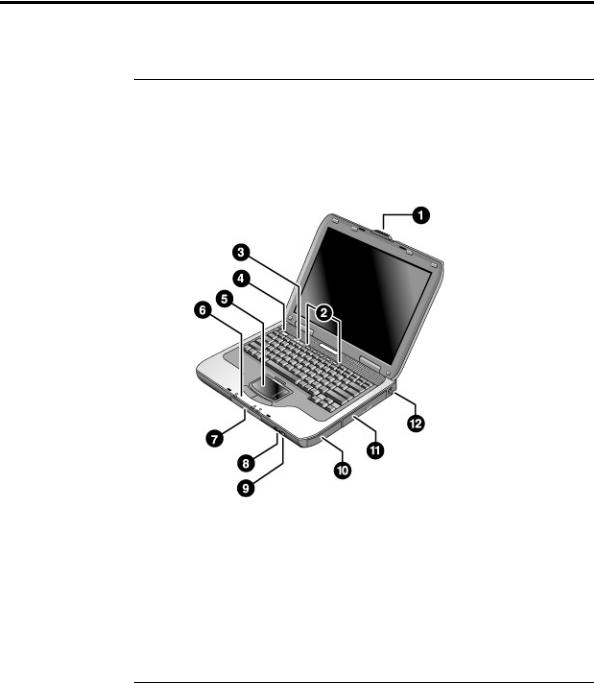
Getting Started with Your Notebook
Identifying Parts of the Notebook
Identifying Parts of the Notebook
|
Series 2100 and N1050v |
|
|
NOTE |
Components included with the notebook may vary by geographical region and the |
|
features you selected. The following illustrations identify the standard external |
|
components included with most notebook models. |
|
|
1 |
Notebook open/close latch. |
7 |
Hard disk drive. |
|
2 |
One-Touch buttons. |
8 |
Infrared port (select models only). |
|
3 |
Keyboard status lights. |
9 |
Wireless on-off button and indicator light |
|
4 |
Power button. Turns the notebook on and off. |
|
(select models only). |
|
10 |
Battery. |
|||
5 |
TouchPad, scroll pad, Click buttons, and |
|||
11 |
|
|||
|
on-off button. |
CD-ROM, DVD, or other drive. |
||
6 |
Main status lights (left to right): power mode, |
12 |
PS/2 port. |
|
|
hard disk activity, and battery. |
|
|
2 Reference Guide
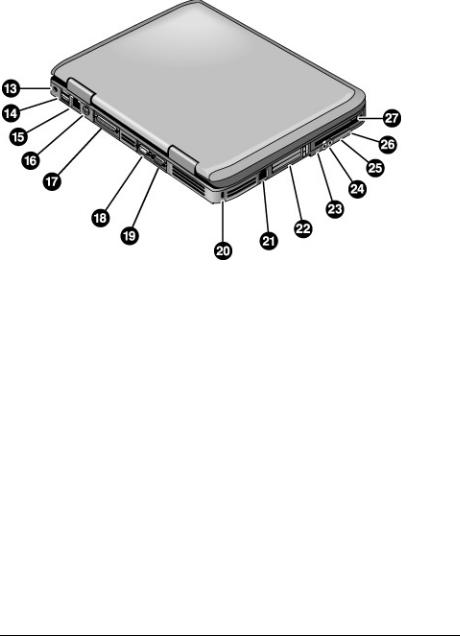
Getting Started with Your Notebook
Identifying Parts of the Notebook
13 |
AC adapter jack. |
20 |
Kensington lock slot (security connector). |
|
14 |
Universal serial bus ports (USB). |
21 |
RJ-11 jack. Connects the modem cable. |
|
15 |
RJ-45 jack. Connects a network cable. |
22 |
PC Card and CardBus slot and button. |
|
16 |
S-video out jack. |
23 |
IEEE 1394 port (select models only). |
|
17 |
Parallel port (LPT1). Use this port for a parallel |
24 |
Audio jacks (left to right): external microphone, |
|
|
printer or other parallel device. |
|
audio out (headphones). |
|
18 |
Serial port (COM1). Use this port for a serial |
25 |
Volume control. |
|
|
mouse, modem, printer, or other serial device. |
26 |
Audio mute button and audio mute light. |
|
19 |
External monitor port. |
|||
27 |
Floppy disk drive (select models only). |
|||
|
|
Reference Guide |
3 |
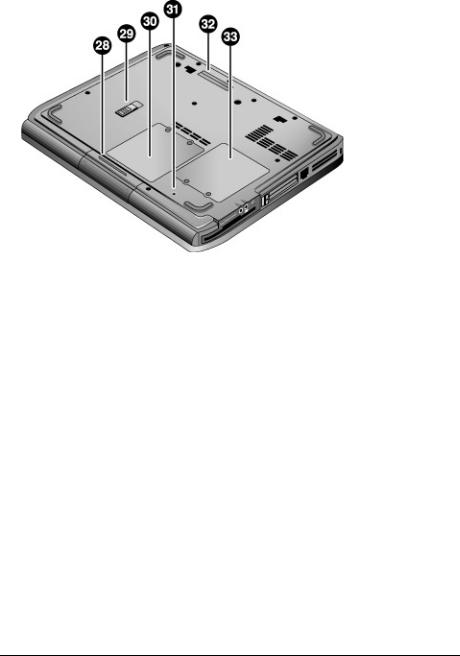
Getting Started with Your Notebook
Identifying Parts of the Notebook
28 |
Hard disk drive. |
31 |
Reset button. |
29 |
Battery latch. |
32 |
Docking port (select models only). |
30 |
RAM (memory) cover. |
33 |
Mini-PCI cover (no user parts inside). |
4 Reference Guide
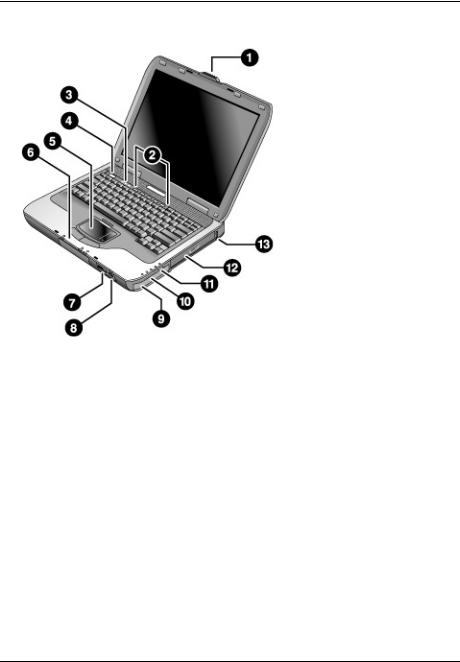
Getting Started with Your Notebook
Identifying Parts of the Notebook
Series 2500
1Notebook open/close latch.
2One-Touch buttons.
3Keyboard status lights.
4Power button. Turns the notebook on and off.
5TouchPad, scroll pad, Click buttons, plus on-off button.
6Main status lights (left to right): power mode, hard disk activity, and battery.
7Infrared port (select models only).
8Wireless on-off button and indicator light (select models only).
9Battery.
10Audio mute button, audio mute light, and volume control.
11Audio jacks (left to right): audio out (headphones), external microphone.
12CD-ROM, DVD, or other drive.
13Universal serial bus port (USB).
Reference Guide |
5 |

Getting Started with Your Notebook
Identifying Parts of the Notebook
14AC adapter jack.
15Two USB ports.
16RJ-45 network jack. Connects a network cable.
17PS/2 port.
18Parallel port (LPT1). Use this port for a parallel printer or other parallel device.
19External monitor port.
20S-video out jack.
21Kensington lock slot (security connector).
22RJ-11 jack. Connects a modem cable.
23IEEE 1394 port (select models only).
24PC Card and CardBus slot and buttons.
25Floppy disk drive (select models only).
6 Reference Guide

Getting Started with Your Notebook
Identifying Parts of the Notebook
26 |
Hard disk drive. |
29 |
RAM (memory) cover. |
27 |
Battery latch. |
30 |
Docking port (select models only). |
28 |
Mini-PCI cover (no user parts inside). |
31 |
Reset button. |
Reference Guide |
7 |

Getting Started with Your Notebook
Identifying Parts of the Notebook
Status Lights
The notebook includes a number of status lights that report power and battery status, drive activity, and keyboard functions such as Caps Lock and Num Lock.
The following diagram shows the main status lights on the front of the notebook.
1Power mode.
•On: the notebook is on (even if the display is off).
•Blinking: the notebook is in Standby.
•Off: the notebook is off or in Hibernation.
2Hard disk drive activity.
On: notebook is accessing the hard disk drive.
3Battery status.
•Green: the AC adapter is connected and the battery is fully charged.
•Amber: the AC adapter is connected and the battery is charging.
•Blinking: the AC adapter is connected and the battery is missing or has a fault.
•Off: the AC adapter is not connected.
8 Reference Guide

Getting Started with Your Notebook
Identifying Parts of the Notebook
The keyboard status lights, located above the keyboard, indicate the states of the keyboard locks.
1Caps Lock On: Caps Lock is active.
2Num Lock On: Num Lock is active. (The Keypad Lock must also be on to use the embedded keypad.)
3Keypad Lock On: The embedded keypad is active (Fn+F8). Num Lock must also be on for the numeric keys. Otherwise, cursor control is active (as marked on an external keyboard).
Reference Guide |
9 |

Getting Started with Your Notebook
Setting Up Your Notebook
Setting Up Your Notebook
WARNING
WARNING
Improper use of keyboards and other input devices has been associated with ergonomic injury.
If you are using your notebook as your primary computer, or using it for extended periods, you should use it with a full-sized keyboard, monitor, and mouse. Docking accessories offer quick, easy connections to these devices. This can reduce the risk of ergonomic injury.
For information about setting up a safe and comfortable work environment, see the Safety & Comfort Guide on this CD.
When you set up your notebook for the first time, you’ll charge the battery, connect the AC adapter, turn on the notebook, and run the Windows setup program.
Step 1: Insert the battery
Do not mutilate or puncture batteries. Do not dispose of batteries in fire, or they can burst or explode, releasing hazardous chemicals. Rechargeable batteries must be recycled or disposed of properly.
Your notebook is shipped with the battery installed. If the battery has been removed, you should install it:
1.Turn the notebook upside down.
2.Insert the connector end of the battery into the battery compartment and slide it in until it latches.
10 Reference Guide
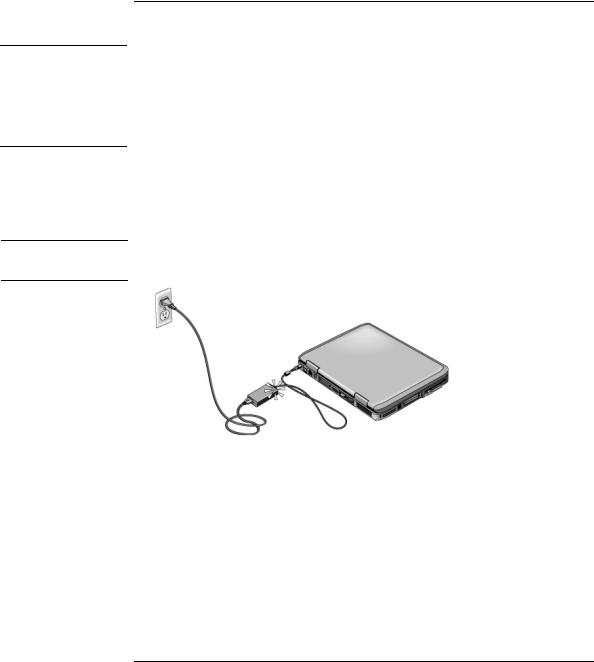
CAUTION
Important
Getting Started with Your Notebook
Setting Up Your Notebook
Step 2: Connect AC power
Use only the AC adapter included with your notebook (or other approved adapter that meets the power requirements of the notebook).
Using the wrong AC adapter could damage the notebook or adapter, cause data loss, and may void your warranty. (See the printed document Worldwide Limited Warranty and Technical Support that came with the notebook.)
1.Plug the AC adapter into the notebook.
2.Connect the power cord to the AC adapter.
3.Plug the power cord into a wall outlet. The notebook battery then starts charging.
When unplugging the power cord, unplug it from the outlet before unplugging it from the AC adapter.
While the battery is charging, you can continue with step 3.
Reference Guide 11

Getting Started with Your Notebook
Setting Up Your Notebook
Step 3: Connect a phone line
1.Make sure the telephone line is an analog line, sometimes called a data line. (You must not use a digital line.)
2.Connect the telephone cord (RJ-11) into a telephone jack
3.Plug the other end of the phone cord into the RJ-11 modem jack in the side of the notebook.
For details about using the modem, see “Using the Modem” in this guide.
12 Reference Guide

Getting Started with Your Notebook
Setting Up Your Notebook
Step 4: Turn on the notebook
Press the power button above the left side of the keyboard. The notebook then boots up, and Windows starts automatically.
Hint |
If your notebook does not turn on when operating on battery power, the battery may |
|
be out of power. Plug in the AC adapter and press the power button again. Leave |
|
the AC adapter plugged in for at least an hour or up to 3 hours to charge it fully. |
|
|
Step 5: Set up Windows
Your notebook has the Microsoft Windows operating system preinstalled on its hard disk drive. The first time you turn on your notebook, the Windows Setup program runs automatically so you can customize your setup.
1.Follow the Setup program instructions on the screen. If the program prompts you to enter the Product ID code, you will find this code on the bottom of the notebook.
2.Check the modem’s country or region settings. Select Start > Control Panel > Printers and Other Hardware > Phone and Modem Options > then choose your country/region..
Reference Guide 13

Basic Operation
Reference Guide 15

Basic Operation
Operating Your Notebook
Operating Your Notebook
You can start and stop your notebook using the power button. However, at certain times you may want to use other methods to start or stop the notebook, depending on power considerations, types of active connections, and startup time.
Default power settings
Power mode |
To enter this mode |
Function |
|
|
|
|
|
ON—Power status |
Briefly press the power button. |
Powers on the notebook. |
|
light will turn on. |
|
|
|
|
|
|
|
OFF—Power |
Select Start > Turn Off Computer > |
Powers off the notebook. |
|
status light will |
Turn Off. If the system has stopped |
|
|
turn OFF. |
responding and Windows shut |
|
|
|
down procedures cannot be used, |
|
|
|
press and hold the power button for |
|
|
|
4 seconds to turn off the notebook. |
|
|
|
|
|
|
Standby—Power |
Select Start > Turn Off Computer > |
• |
Saves significant power. |
status light will |
Stand By. |
• |
Turns off the display and |
blink. |
-or- |
|
other components. |
|
Allow the system to time out. |
• |
Maintains current session |
|
|
||
|
|
• |
in RAM. |
|
|
Restarts quickly. |
|
|
|
• |
Restores network |
|
|
|
connections. |
Hibernation— |
If the unit is already on, briefly |
• |
Saves maximum power. |
Power status light |
press the power button. |
• |
Saves current session to |
will turn off. |
-or- |
|
disk, then shuts down. |
|
Press Fn+F12. |
• |
Restores network |
|
-or- |
||
|
|
connections. |
|
|
Allow the system to time out. |
|
|
|
|
|
|
|
|
|
|
You can also customize the way power modes work. See the “Batteries and Power
Management” chapter in this guide.
16 Reference Guide

Basic Operation
Operating Your Notebook
To reset the notebook
Occasionally, you may find that Windows or the notebook has stopped responding and will not let you turn off the notebook. If this happens, try the following in the order listed:
•If possible, shut down Windows: press CTRL+ALT+DEL, and then select Shut Down, Restart.
–or, if this fails–
•Press the power button for at least 4 seconds until the display shuts down. Unsaved data will be lost. Press the power button again to restart.
–or, if this fails–
•Insert the tip of a paper clip into the reset button on the bottom of the notebook, and then press the power button to restart.
To reset the notebook while it’s docked in a port replicator, you can press the reset button on the left side of the port replicator.
To change the boot device
The notebook normally boots from its internal hard disk. You can also boot the notebook from a floppy disk drive, a CD-ROM drive, or an internal network interface card.
1.Select Start > Turn Off Computer > Restart.
2.When the logo screen appears, press ESC to display the Boot menu.
3.Use the arrow keys to select the boot device, and press ENTER.
If you want to boot from a specific device whenever it is present, change the boot order using the BIOS Setup utility. See “Configuring the Notebook” in the “Troubleshooting and Maintenance” chapter in this guide.
Reference Guide 17

Basic Operation
Operating Your Notebook
To use the TouchPad
The TouchPad includes an on-off button so you can turn off the TouchPad to avoid moving the pointer accidentally when you are typing. The indicator light turns off when you turn off the TouchPad.
1Select buttons. The Select buttons work like the left and right buttons on a standard mouse.
2TouchPad (touch-sensitive pointing device).
3TouchPad on-off button and indicator light.
4Scroll pad. The scroll pad scrolls vertically to display the contents of the active window.
18 Reference Guide

Basic Operation
Operating Your Notebook
To use the function hot keys
The combination of the Fn key plus another key creates a hot key—a shortcut key sequence—for various system controls. To use a hot key, press and hold Fn, press the appropriate second key, and then release both keys.
This hot key |
Does this |
Fn+F1 |
Decreases the display brightness. |
|
|
Fn+F2 |
Increases the display brightness. |
|
|
Fn+F5 |
Toggles among the built-in display, an external |
|
display, and simultaneous display on both. |
|
|
Fn+F8 |
Toggles the built-in keypad on and off. Does not |
|
affect an external keyboard. If Num Lock is on, |
|
then the numeric functions are active; |
|
otherwise, cursor control is active (as marked |
|
on an external keyboard). |
|
|
Fn+F12 |
Initiates Hibernation. |
|
|
Fn+NumLock |
Toggles Scroll Lock on and off. |
|
|
Fn+Page Up |
Increases the audio volume and cancels the |
|
mute setting. |
|
|
Fn+Page Down |
Decreases the audio volume. |
|
|
Fn+Backspace |
Mutes/unmutes the audio output. |
|
|
Reference Guide 19

Basic Operation
Operating Your Notebook
To use the One-Touch buttons
Your notebook includes five One-Touch buttons that can start any application or open a document or Web site with a single press.
Press the One-Touch button to open the corresponding application, document, or Web site.
To program a One-Touch button
1Select Start > All Programs > Utilities > One Touch.
2On the One-Touch tab, select the button you want to reprogram.
3Type a label for the button, and then select the application, document, folder, or Web site you want the button to open.
4If you want a label to appear onscreen when you press a One-Touch button, select that option on the Onscreen Display tab.
20 Reference Guide

Basic Operation
Operating Your Notebook
To use the Windows and Applications keys
The Windows key brings up the Windows Start menu. This is the same as selecting the Start button on the taskbar.
The Applications key brings up the shortcut menu for the current application. This is the same menu that appears when you right-click while pointing at the application.
This key combination |
Does this |
|
|
Windows key+E |
Runs Windows Explorer. |
|
|
Windows key+F1 |
Runs Windows Help. |
|
|
Windows key+F |
Runs Windows Find: Search. |
|
|
Windows key+M |
Minimizes all displayed windows. |
|
|
Shift+Windows key+M |
Returns all minimized windows to original size. |
|
|
Windows key+R |
Runs the Windows Run dialog box. |
|
|
To use the ALT GR key
Non-U.S. keyboards have an ALT GR key to the right of the spacebar. This is a shift key that provides access to certain special keyboard characters.
For a character in the lower-right corner of a key, press and hold ALT GR to type the character.
1Shifted
2Unshifted
3ALT GR
Reference Guide 21

Basic Operation
Using CDs or DVDs
Using CDs or DVDs
|
To insert or remove a CD or DVD |
|
|
CAUTION |
Do not remove a CD or DVD while the notebook is reading it, or the notebook |
|
could stop responding and you could lose data. |
To avoid damage to the disk or drive, be sure to press the CD or DVD firmly onto the spindle.
1.Press the button on the face of the CD or DVD drive. If you are using this drive for the first time, be sure to remove the cardboard packing insert if present.
2.Press the CD or DVD gently but firmly onto the spindle (label facing up). –or–
Remove the CD or DVD.
3.Slide the tray back into the module to close it.
If your notebook loses power, you can manually open the drive to remove a CD. Insert a straightened paper clip into the recessed hole on the front of the drive to open it.
The location of the CD or DVD drive varies by model.
22 Reference Guide
